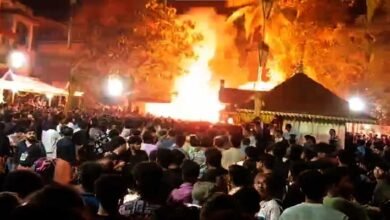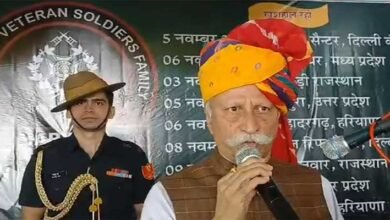Arunachal DCM Chown Mein attends Himalayan State conclave

Addressing the Himalayan State Conclave , Arunachal Pradesh DCM Chowna Mein sought for setting up the Headquarter of North East Water Management Authority at Itanagar.
Mussoorie
Deputy Chief Minister Chowna Mein attended the one-day Himalayan State conclave at Mussoorie on Sunday. The objective of the conclave was to discuss various issues related to development of Himalayan States. Union Finance Minister Nirmala Sitharaman inaugurated the one-day Himalayan conclave.
Mein while laying emphasis on the importance of the conclave said that the issues which are common to all Himalayan states need timely intervention from the Fifteenth Finance Commission. He hoped that genuine concerns will be looked into proper perspective by the Commission and it will make appropriate and specific recommendations for the Himalayan States to the Government of India.
“The Joint Memorandum of the Himalayan States to be submitted to the 15th Finance Commission is a significant initiative”, said Mein and added that it is in the right direction and very clearly puts forward the common concerns of all Himalayan states.
Mein laid stress that the criteria for ecosystem services should only be based upon absolute forest area in the state as Arunachal Pradesh has a quality forest cover of 82% of the total area and thus provides invaluable ecological services to the nation and the world as carbon sink.
However, this very asset has become a development disability for the State and its people. In the name of conservation of the forest for larger good, the local people are deprived of modern facilities of development as no compensation has yet been given to the State for this invaluable contribution, added Mein.
He further added that the State has a stock of 148.52 tonnes of carbon stock per hectare which is highest in the country and its value is estimated to be about Rs. 48000.00 crores annually. The forest cover of the State requires due cognizance, which has been ensured in our suggested formula. The 14th Finance Commission had recognized this factor, but now, the earlier weightage is required to be enhanced in keeping with the economic implication arising from some denudation of the State’s forest cover and agricultural practices affecting the same.
Mein advocated that the scientific Vulnerability Index may be used to devolve the funds between states as the Himalayan States are located in high seismic Zone and are highly vulnerable to earthquakes along with other natural disasters.
Stating that one of the biggest challenges which the Indian Himalayan Region faces is the annual devastation caused by relentless monsoons. There is massive destruction of roads and other infrastructures. The current norms of disaster relief under SDRF/NDRF guidelines are far too meagre to restore the infrastructure. Our state has been unable to restore the rain damages that have been accumulating over the years. We are left with a mammoth task of restoring damages, which our state is unable to carry out due to its meagre resources, added DCM.
Speaking on Climate change, Mein said it is one of the most important global environmental challenges that affect all the natural ecosystems of the world. Due to the fragile environment, mountain ecosystems are the most vulnerable to the impact of climate change. Climate change will not only threaten the biodiversity, but also affect the socio-economic condition of the indigenous people of the state.
He added that various activities like habitat loss, deforestation, clear felling and overexploitation amplify the impact of climate change on biodiversity. The Jhum / shifting cultivation in the State is a major concern; this aggravates the impact of climate change on water resources, and soil erosion due to massive loss of forest cover.
One would expect Arunachal Pradesh to appear more vulnerable when compared to other states owing to the fact that it has a large area under slope greater than 30%, low road density, least livestock to human ratio, lowest percentage of area under horticulture crops, least participation in MGNREGA, no crop area under insurance and low percentage of farmers taking loans thereby minimizing our CD ratio.
Mein suggested that there is a need for holistic and integrated planning to tap the water resources of the North Eastern Region for optimum utilization. Initiative of Hon’ble Prime Minister for creation of North East Water Management Authority which is in the process of finalization by NITI Aayog will go a long way in fulfilling the objective of optimization of water resources in the North Eastern Region, he added.
DCM sought for setting up the Headquarter of North East Water Management Authority at Itanagar.
Mein reiterated that there is huge scope for development of sustainable tourism in the Himalayan states for which adequate investment is required for development of basic infrastructure in the small urban centres in the Himalayan region. It must be managed so that it focuses on marginalised areas and groups, ensures jobs, promotion of local culture, tourism products and also contributes to achieving the Sustainable Development Goals (SDGs), particularly Goal 8 (‘Decent work and economic growth’) and Goal 12 (‘Responsible consumption and production’).
Citing that although infrastructure development has been accorded top priority in the strategy of the State’s economic development over the four decades of planning Arunachal Pradesh is lagging behind the national average in most of the components of infrastructure.
Mein stated the development of infrastructure, roads, power and telecommunication in Arunachal Pradesh has not been able to keep pace with that in the rest of the country. The vastness of the territory and rugged, difficult and inaccessible terrain has negated the benefits to the rural masses that are in the interior parts of the State.
He said that the per capita cost of providing not only physical infrastructure but also public services is very high in the Himalayan Region. The geographical area in plains and hills is determined in 2D plane and the folds/ undulations in hilly terrain are not accounted for while determining the overall area. An exercise done by Himachal Pradesh using modem Geo-IT tools, remote sensing and GIS indicates that the 3D area of the state comes out to be 56% more than the 2D area. Similarly for Arunachal Pradesh, the 3D area will also be at least 50% more than 2D of 83,743 sq.km. These factors are required to be considered while assessing availability of social and physical infrastructure per unit of area.
Mein also laid focus on the Cost Disability Index be given due weightage while allocating resources among the States. He said that Arunachal Pradesh, being a highly precipitated area, the working season is restricted only for 6 months i.e. from October to March every year. Inadequacy of own resources and insufficient central assistance after independence, despite liberal treatment, coupled with high cost per unit of development, have been important factors for the backwardness of the state.
To remove the critical gaps in Physical and Social infrastructural needs, DCM suggested to strengthen the economic conditions of the people living in the remote border blocks and to arrest the stress migration from the border areas towards the plains, Fifteenth Finance Commission should make specific recommendation specially for states with strategic importance vis-à-vis International border, added Mein.
Speaking on Externally Aided Projects, Mein highlighted that Arunachal Pradesh is perhaps the only state in North-East which has been deprived of the externally aided projects from the World Bank, ADB and JICA due to opposition from China. This not only deprives the state of financial benefits but also of technical knowledge that comes with External Aided Projects besides being a big deterrent in our developmental activities.
He urged upon the Commission to make suitable recommendations for making alternative arrangements with regard to Externally Aided Projects.
Mein said there is a need for deciding on a new institutional arrangement which recognizes the need of Special Category States and provides for a weightage or a norm to enable compensatory transfers, keeping in view the declining trend of the share of statutory Finance Commission transfers vis-a-vis non-discretionary erstwhile Plan and Non-Plan transfers.
“Our request for accordance of Special Category Status to all the States of Indian Himalayan Region may be considered due to challenges being posed by Cost Disability factor, huge infrastructural deficit in the critical sectors, hilly terrain, hostile topography, migration from border areas and serious connectivity issues etc.” said Mein.
He also requested the Fifteenth Finance Commission to take into account the factors concerning area, population, economic backwardness contingent on infrastructure deficit, inadequate financial inclusion of people at large, constraints in obtaining goods and services at economic rates, etc while fixing share of the state in central taxes.
He deliberated that the Government has projected an economically rational basis for devolution of the Centre’s divisible resources, keeping in view the formulae devised by past Finance Commissions, our past experience on actual transfer of Central resources and most importantly, the evolving internal socio-economic milieu of Arunachal Pradesh and its geopolitical disposition.













